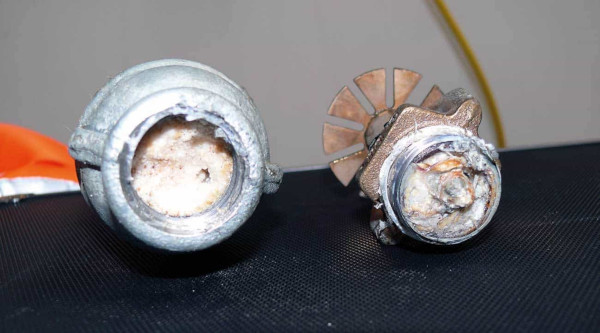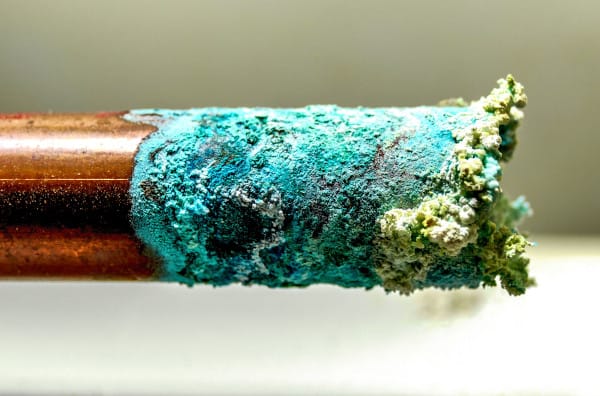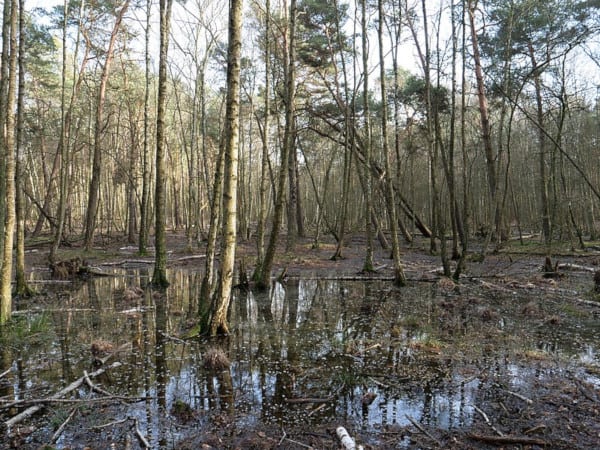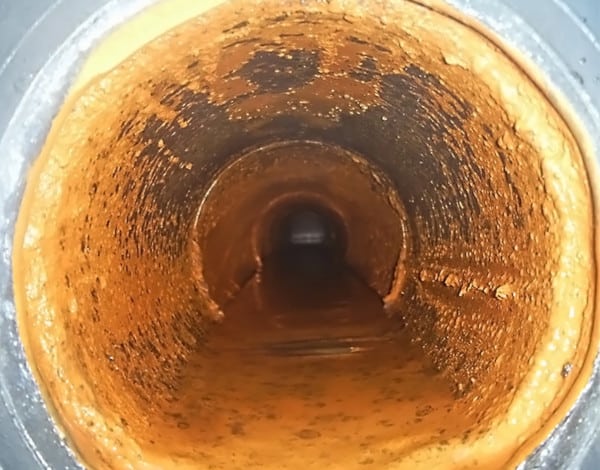Chemical and biological processes can cause fire sprinklers to spray an opaque, thick liquid with a noxious scent
Discharge from a fire sprinkler pipe, or any other water-based fire protection system, often contains discolored water—and plenty of it. That dirty (and sometimes rank) liquid can quickly soak people and property when a fire sprinkler head opens. Although the culprits range from chemical or microbiologically influenced corrosion (MIC) to mere mineral deposits, the result can be punishing to occupants’ senses and building owners’ budgets alike.
In this article, we explain why discolored water sprays from fire sprinkler pipes. We look at the factors leading to color differences, provide some clues about the color’s source, and discuss what building owners and responsible parties can do to prevent or recover from the resulting water damage.
If you’re one of those responsible parties, consider minimizing any damage from an accidental activation with our line of Shutgun fire sprinkler tools, or getting the system into service with testing and monitoring equipment, pipe fittings and accessories, and replacement fire sprinklers.
A “baptism” and a wedding illustrate the perils of discolored water inside fire sprinkler pipes
It’s safe to suppose that most people haven’t ever seen a fire sprinkler head open. For the most part, that’s a good thing. But in the absence of knowledge or first-hand experience, myths about fire sprinkler systems proliferate. One such myth—kept alive by films like Lethal Weapon 4—is that the water in fire sprinkler pipes is usually clean.
In many cases, that couldn’t be further from the truth. And there’s no worse time to learn how sludgy, smelly, and colorful sprinkler water can be than at a wedding. In College Park, Georgia, a hotel fire sprinkler drenched members of one wedding party in a “black oily substance.” The incident didn’t stop the ceremony—although it did leave the bride with a stained wedding dress and several attendees seeking treatment for breathing problems.
Experienced sprinkler fitters are all too familiar with the foul-smelling, viscous substance that can spew from a standpipe or fire sprinkler pipe. Chris Johnson, president and CEO of a Florida-based installation and inspection firm, explained that fire professionals call a novice fitter’s first encounter with dirty water “the ‘Baptism.’”
“Basically,” he said, “the poor unsuspecting helper opens a pipe, or pulls a fire sprinkler that has some trapped water behind it. The water in older systems tends to stagnate and the water in the pipe will become a thick black, smelly, sludge. There is nothing that will tickle an experienced fire sprinkler man’s fancy like seeing his helper covered from head to toe in black stinky sludge.”

Chemical and MIC corrosion are among the likeliest causes of discolored water in fire sprinkler pipe
Cleaning up discolored water can be an unpleasant and costly process. Acts of vandalism and carelessness involving sprinklers can cost tens or even hundreds of thousands of dollars to repair. But before dwelling on the damage sprinkler water can cause, it’s worth noting they dramatically reduce the volume of water used during a fire. Compared to fire hoses, sprinklers may cut water use by a factor of ten or more.
Still, why does this discharge look (and smell) the way it does? In a word: corrosion. Rust forms when electrons in metal combine with oxygen. Water, acids, and other chemicals wear away at metallic surfaces. In the process, substances like iron dissolve, releasing electrons until they exhaust the oxygen in the surrounding air or water. These reactions create oxides (substances made of oxygen and one other element) or salts from the metal, transforming metal’s color and reducing its strength.
Corrosion isn’t the only source of discolored water in fire sprinkler pipes—but it’s a troublingly common problem. Studies cited in the 2007 edition of the Automatic Sprinkler Systems Handbook estimate that microbially induced corrosion (MIC)—where microbial life in piping systems slowly destroys metal—is present in 40 – 60% of sprinkler system leaks. More recent studies place corrosion, generally, as the fourth most costly cause of sprinkler system failures.

There are other, less worrying sources of discolored water in piping systems that affect pipe made of any material. Dirt and sediment in water supply lines may give water a yellow or brown color. Iron and manganese may settle in some pipelines during periods of low water use. Sometimes, these particles come from the water source itself—be it a well, river, or tank. Those particles may radically change water’s appearance when a water main breaks or supply lines face heavy use.
Generalized corrosion gives discolored water a variety of hues
Between 70 and 90% of corrosion is simply oxygen or “generalized” corrosion—a strictly electrochemical process. To put it crudely, positive and negative charges (from metal, water, and other substances) cause changes in the chemical make-up of the fire sprinkler pipe. In well-maintained pipes with good drainage, generalized corrosion proceeds somewhat slowly. MIC corrosion, on the other hand, can quickly damage the piping as a whole and produce pockets of concentrated wear.
A fact sheet from the Washington State Department of Health notes that generalized corrosion may be responsible for several forms of discolored water, including:
- Green or blue—indicative of rust in copper pipes
- Brown, red, orange, or yellow water—often caused by iron rust, affecting steel and galvanized or cast-iron pipes

As cast-iron pipe corrodes—or the scales it forms dissolves—it creates ferric iron that may turn the water red or rust-colored. “Alternating periods of stagnation, anaerobic conditions, and temperature have been observed to cause red water,” says the American Water Works Association (AWWA), an international nonprofit specializing in water management.
However, iron corrosion may also result in the release of ferrous iron, which has a yellow or black color. The latter tends to occur in water with low levels of dissolved oxygen. While it’s enough to stain clothes and furniture—and may have a somewhat metallic smell—it’s harmless.
MIC corrosion can fill fire sprinkler pipe with rank, sludgy, discolored water
The smells and textures that sometimes accompany discolored water may indicate that worrisome transformations have started inside water-based systems. As bacteria consume iron, they leave can leave behind a biofilm or slime that’s often reddish-brown or yellow. Kits made for tests of MIC corrosion and other problems occurring in fire sprinkler pipe may look for several different types of bacteria, including:
- Heterotrophic bacteria (carbon-eating bacteria)
- Iron-related bacteria (which either metabolize or create deposits of iron)
- Slime-forming bacteria (iron-related bacteria that generate white, beige, grey, or black slime)
- Sulfate-reducing bacteria (which may turn water black and are responsible for much of discolored water’s smell in fire protection systems)
- Acid-producing bacteria (responsible for rapid pitting in some piping systems, these organisms may have contributed to a major Alaska pipeline leak in 2006)
Smells, sheens, and colorful slimes are hallmarks of MIC corrosion
There are, broadly speaking, two types of odors that may accompany discolored water: a sulfurous, rotten-egg smell or an earthy, moldy scent. The Minnesota Department of Health explains that the former smell—sometimes found in plumbing systems that rely on well water—comes from hydrogen sulfide, and is commonly produced by two mechanisms:
- Microscopic flatulence. Anaerobic bacteria, which thrive in airless environments, digest organic material and release gas into the water supply.
- Chemical reactions. Some types of metal used to control corrosion can transform sulfates in the water to hydrogen sulfide.

Another common smell—described as “moldy” or “earthy”—indicates that bacteria or organic matter have entered the system. While the odors are generally less offensive, these smells may also indicate the presence of either:
- Iron-related bacteria. Like other bacteria, these may produce a “rotten egg” smell. But it’s also described as having the scent of fuel oil or even cucumber. In addition to being discolored, water in systems with these bacteria may have an oily sheen or even globs of slime.
- Sulfur bacteria. This category includes both the anaerobic, sulfate-reducing bacteria mentioned above and sulfur-oxidizing bacteria, which need oxygen to live. The latter type resembles iron bacteria in behavior, with their most detectable characteristic being the production of slime.
Minimizing or mitigating damage caused by discolored water—and the effects of corrosion—is an important step for building owners
Not all discolored water indicates a serious problem in a fire sprinkler pipe. Minerals and low levels of generalized corrosion may not require immediate action. But when water starts to take on other characteristics—from smelling really bad to containing slime—it’s likely time to investigate the condition of the system.
This article may have raised more than a few questions about discolored water, water damage, and the steps needed to keep corrosion in check. We’d like to close by answering some of them and pointing readers to more in-depth information.
Are corrosion and discoloration inevitable?
Well, they’re likely, anyway. At least, in metal pipe. Data from VdS, one of Germany’s most well-known institutions for risk management in fire protection, estimates that corrosion will damage 35% of wet-pipe fire sprinkler systems so severely that they will require partial or complete replacement within 25 years. Dry-pipe and preaction systems are far worse off. In less than 13 years, nearly three-quarters of those systems will have some serious form of corrosion.
These statistics apply to metal fire sprinkler pipe. Conversely, pipe made from chlorinated polyvinyl chloride, or CPVC, basically doesn’t corrode. CPVC, like many plastics, doesn’t have the right chemical properties for these changes to occur. While the use of these pipes is generally limited to light hazard settings like family homes, relatively small residential housing, and occupancies faced with little fire risk, CPVC can eliminate one substantial source of system degradation and much of the discolored water that follows in its wake.
Should building owners flush discolored water from fire sprinkler pipes more often?
It’s a tempting approach. Why not replace dirty, discolored water with fresh, clean water? While stagnant water has a deserved reputation as a bacterial breeding ground, flushing can feed bacteria living in fire sprinkler pipe. After all, electrochemical corrosion—and some forms of MIC corrosion—rely on oxygen. Introducing fresh, untreated water into the system can reoxygenate water, accelerating these changes.
This is why dry pipe systems are especially vulnerable to corrosion. When the system is flooded and drained, some water is left behind that mixes with an abundant supply of oxygen. The result? Faster corrosion in portions of the system.
What can be done to eliminate MIC corrosion and discolored water?
We’ve taken a look at some options in “My Fire Sprinkler Pipes are Corroded. Now What?” To sum up:
- Damaged fire sprinkler pipe may require partial or total replacement, depending on the severity of the problem.
- In dry-pipe systems, replace pressurized air with an oxygen-free alternative, such as nitrogen. NFPA 13 also stipulates that portions of the pipe system should be angled to better drain it.
- Avoid galvanized steel piping.
- Implement a corrosion-monitoring program.
- Install devices that vent air from the system, reducing the amount of oxygen available to bacteria.
How can water damage be minimized after a sprinkler activates?
If a fire sprinkler activates to control a fire, let it do its work. Some dirty water is a small price to pay for saving lives and far greater property damage. You can take a proactive approach to water damage from mistaken activations, however. Sprinkler shutoff tools like Shutgun provide staff members and occupants with an easy way to stop the flow of water from individual sprinkler heads.

You can also consider vandalism- and accident-resistant fire sprinkler heads, such as the “institutional” fire sprinklers used in correctional facilities or concealed types used in sanitary environments. And always, always familiarize staff members with the locations of valves used to shut off fire sprinkler systems.
What should be done after sprinkler water damage?
Seek a qualified contractor for cleanup. Removing discolored water quickly can reduce staining and prevent long-term damage to the building. By the same token, quickly restoring a fire sprinkler system to service can eliminate the need to evacuate occupants, shut down a business, or maintain a fire watch.
For more, check out our guide to selecting a qualified standpipe or fire sprinkler contractor who can replace fire sprinkler heads, check on the system, and determine what problems, if any, are indicated by the discolored water flowing from your sprinkler system.
Consumers looking to keep water damage in check (or to repair an existing system) may be interested in a wide variety of fire protection equipment, including:
- Shutgun fire sprinkler tools
- Testing and monitoring equipment
- Pipe fittings and accessories
- Fire sprinklers
For a range of articles on issues that impact fire sprinkler pipes—including piping selection, inspection, and corrosion—check out the rest of our blog. And, as always, feel free to ask us questions about these articles or our products at +1 (888) 361-6662 or support@qrfs.com.
This blog was originally posted at blog.qrfs.com. If this article helped you, check us out at Facebook.com/QuickResponseFireSupply or on Twitter @QuickResponseFS.



Basically, the poor unsuspecting helper opens up a pipe, or pulls a fire sprinkler that has some trapped water behind it. Excellent explanation. Anyone can easily comprehend since it’s simple & focused. Keep up the great work!
Very good information. I’m an insurance broker. A client who lives on first floor of a 3 floor
condominium had water damage from sprinkler release on 3rd floor when a plumber’s
hot work set off the sprinkler system. HVAC contractor for first floor says entire system
needs to be replaced due to the chemicals that came down three floors in the walls and
into the HVAC system. Contractor further states workmen cannot “clean” the HVAC
system due to the chemicals. Seems like a ploy to sell a new system. Your article does not
seem to mention any toxicity or danger in the expelled water.
Opinion? PS – a long ago Roanoke College grad. Loved playing soccer and golf against Randolph Macon
many decades ago! Love your town.
Randolph — A key distinction in your situation may be whether the sprinkler system used antifreeze in cold weather months, in which case it would contain chemicals. Otherwise, sprinkler water can be pretty dirty but usually doesn’t contain anything other than water that’s stagnant (and all that can entail). Whether this created irredeemable damage is beyond our knowledge—perhaps try for another quote from an HVAC company and determine whether it was a wet system using antifreeze. Best of luck and thanks for the Richmond shout-out!
Our 12 story building just had standpipe testing and passed. I thought the fire system was completely separated from the drinking water system, but our drinking water was brown. What causes this contamination of our drinking water when the standpipe system is tested?
Max — We have no perspective of how standpipe testing would contaminate drinking water, as plumbing is an entirely different system (unless someone did something very odd while connecting pipes!). You should have a plumber assess the issue with the drinking water and bring in a fire protection contractor if any issues turn out to be somehow related. But standpipes are not part of the potable or non-potable plumbing network.
Perhaps the flow rates used in standpipe testing and refill caused high velocities which pulled in discolored water from upstream of the split from standpipe and domestic water systems.
Possibly! Thanks for reading, Randy.
On our site we have an emergency feed from our public water supply back feeding the fire water system in case that our main supply runs out. It is protected by a reverse pressure zone/ back flow preventer assembly which consists of a check valve with a open to atmosphere drain. Maybe this is the same for your system?
This should undergo quarterly/ biannually inspections to ensure the RPZ is working effectively and no contaminated fire water can go back into the regular water… hope this helps.
Regular testing as per NFPA 13 & NFPA 25 can avoid this problem. In my project, drain out total water quarterly.
Are microbiologically influenced corrosion hazardous to sprinkler men ?
Eddie — You mean people working on sprinklers? When these conditions are present in stagnant water, the stagnant water isn’t exactly clean or healthy for people, but MIC itself does most of its specific damage to materials.
can clothing and furniture be damaged by contaminants from the sprinkler system? if yes, is it best to just discard those items?
Frank — The short answer is “it’s possible.” Sprinkler water can get pretty dirty, but you’d have to ask cleaning professionals to see if something can be salvaged. Thanks for reading!